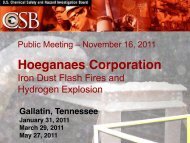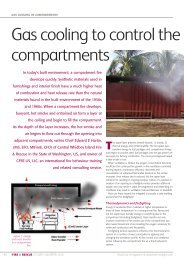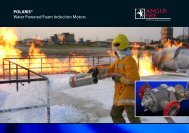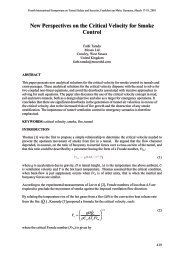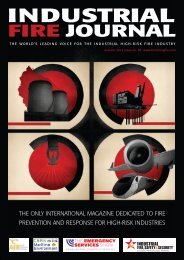Safety and Reliability of Fire Detection Systems in Road Tunnels
Safety and Reliability of Fire Detection Systems in Road Tunnels
Safety and Reliability of Fire Detection Systems in Road Tunnels
You also want an ePaper? Increase the reach of your titles
YUMPU automatically turns print PDFs into web optimized ePapers that Google loves.
Fourth International Symposium on Tunnel <strong>Safety</strong> <strong>and</strong> Security, Frankfurt am Ma<strong>in</strong>, Germany, March 17-19, 2010<br />
<strong>Safety</strong> <strong>and</strong> <strong>Reliability</strong> <strong>of</strong> <strong>Fire</strong> <strong>Detection</strong> <strong>Systems</strong> <strong>in</strong> <strong>Road</strong><br />
<strong>Tunnels</strong><br />
Dr. Arnd Rogner<br />
Metaphysics SA<br />
Rue de l’Industrie 19, CH-1450 Sa<strong>in</strong>te-Croix, Switzerl<strong>and</strong><br />
ABSTRACT<br />
Although automatic fire detection is used <strong>in</strong> road tunnels s<strong>in</strong>ce the late sixties, the subject has been <strong>of</strong><br />
grow<strong>in</strong>g importance s<strong>in</strong>ce the big tunnel fires <strong>in</strong> 1999 / 2001. Besides <strong>in</strong>troduction <strong>of</strong> new detection<br />
technologies, safety <strong>and</strong> reliability <strong>of</strong> these systems is an important issue. On one side early detection<br />
versus fault alarm rate has to be considered. On the other h<strong>and</strong> automatic detection versus control room<br />
decision is a subject. And another question is how much redundancy can be put <strong>in</strong>to the budget? This<br />
paper gives an overview on actual tunnel fire detection systems <strong>in</strong>clud<strong>in</strong>g their safety <strong>and</strong> reliability<br />
features.<br />
TUNNEL FIRE DETECTION SYSTEMS<br />
Whereas l<strong>in</strong>e type heat detectors have been used as the most important technology for a long time,<br />
today new technologies as smoke detection, video <strong>and</strong> others have been com<strong>in</strong>g up or are under<br />
<strong>in</strong>vestigation [1]. In addition, many countries started to implement these new technologies for early fire<br />
warn<strong>in</strong>g <strong>in</strong> the directives for tunnel safety equipment [2,3]. Actual systems are:<br />
• Semiconductor temperature sensor cable (multipo<strong>in</strong>t heat detector)<br />
• Fiber optic sensor cable<br />
• Pneumatic l<strong>in</strong>e type heat detector (copper tube system)<br />
• Non resettable l<strong>in</strong>e type heat detectors<br />
• Visibility monitors<br />
• Video analysis<br />
• Flame detectors<br />
Table 1: overview <strong>of</strong> tunnel fire detection systems<br />
System Reacts on Rate-<strong>of</strong>rise<br />
detection<br />
<strong>Detection</strong><br />
speed<br />
Temperature temperature yes middle to<br />
sensor cable<br />
high<br />
Fiberoptic sensor<br />
cable<br />
Pneumatic system temperature yes middle to<br />
high<br />
Non-resettable<br />
cable<br />
Typical<br />
sensor<br />
distance<br />
7 m<br />
10 m<br />
Maximum<br />
system<br />
length<br />
Local<br />
resolution<br />
Fault<br />
alarm<br />
rate<br />
low<br />
2500 m 7 m<br />
10 m<br />
temperature yes middle cont. 8000 m 1-2 m low<br />
cont. 100 m 100 m low<br />
temperature no low cont. 250 m 250 m low<br />
Visibility monitors smoke yes high 100 –<br />
300 m<br />
Video analysis smoke, N.A. high 50 – 100<br />
flames<br />
m<br />
Flame detectors flames N.A. middle 25 – 50<br />
m<br />
po<strong>in</strong>t type 100 –<br />
300 m<br />
po<strong>in</strong>t type 50 –<br />
100 m<br />
po<strong>in</strong>t type 25 –<br />
50 m<br />
middle<br />
high<br />
low<br />
561
Fourth International Symposium on Tunnel <strong>Safety</strong> <strong>and</strong> Security, Frankfurt am Ma<strong>in</strong>, Germany, March 17-19, 2010<br />
A more detailed description <strong>of</strong> these systems is given <strong>in</strong> [1]. Table 1 gives an overview on their most<br />
important properties <strong>and</strong> specifications.<br />
SAFETY<br />
<strong>Safety</strong> is used <strong>in</strong> the sense, that all these systems should detect a tunnel fire. A 5 MW fire (typical car<br />
fire) usually should be detected with<strong>in</strong> 60 seconds. The general trend is, to detect the fire <strong>in</strong> a very<br />
early stage <strong>and</strong> prevent a real breakout or fire jump<strong>in</strong>g to more vehicles. This br<strong>in</strong>gs up the question for<br />
a threshold to be used. Today various types <strong>of</strong> test fires are used to qualify fire detection systems.<br />
While the German RABT [2] uses a 5 MW test fire, Austrian RVS 9.282 [4] starts already with a 1.5<br />
MW fire. Hav<strong>in</strong>g <strong>in</strong> m<strong>in</strong>d high w<strong>in</strong>d velocities <strong>of</strong> up to 10 m/s <strong>in</strong> tunnels, this might be crucial for<br />
temperature detection based systems. Table 2 gives the result <strong>of</strong> the comparison <strong>of</strong> different l<strong>in</strong>e type<br />
heat detectors us<strong>in</strong>g different test fires at a w<strong>in</strong>d velocity <strong>of</strong> 3 m/s [5]. It can be recognized that the<br />
semiconductor sensor cable is the fastest one, although all type <strong>of</strong> systems can detect the fires.<br />
Table 2: comparison <strong>of</strong> different l<strong>in</strong>e type heat detectors us<strong>in</strong>g different test fires [5]<br />
# Fuel Area <strong>of</strong> fire LHD 1<br />
copper tube<br />
LHD 2<br />
fibre optic<br />
LHD 4<br />
sensor cable<br />
1 Petrol 2 m 2 28 s 42 s 13 s<br />
2 Petrol 4 m 2 19 s 30 s 11 s<br />
3 Diesel 2 m 2 83 s 60 s 31 s<br />
4 Diesel 4 m 2 30 s 48 s 17 s<br />
5 n-Heptan 1 m 2 165 s 98 s 46 s<br />
6 n-Heptan 2 m 2 37 s 68 s 18 s<br />
7 n-Heptan 4 m 2 25 s 61 s 13 s<br />
Figures 1 <strong>and</strong> 2 show <strong>in</strong> addition a test with a 5 MW fire done at 10 m/s w<strong>in</strong>d velocity <strong>and</strong> a real tunnel<br />
fire <strong>in</strong> a city tunnel. In both cases the detection has been triggered by the rate-<strong>of</strong>-rise. Significant<br />
absolute temperatures are not reached <strong>in</strong> the first case <strong>and</strong> only reached after several m<strong>in</strong>utes <strong>in</strong> the<br />
second case. This means, that rate-<strong>of</strong>-rise detection is m<strong>and</strong>atory <strong>and</strong> systems work<strong>in</strong>g only by absolute<br />
temperature detection as non-resettable cables should not be used <strong>in</strong> the road tunnels.<br />
Figure 1: Test <strong>of</strong> semiconductor sensor cable<br />
with 5 MW fire at 10 m/s<br />
Temperature [°C]<br />
35<br />
30<br />
25<br />
20<br />
15<br />
10<br />
5<br />
Ignition <strong>of</strong><br />
test fire<br />
0<br />
-80 -60 -40 -20 0 20 40 60 80 100 120 140<br />
Time [s]<br />
S1<br />
S2<br />
S3<br />
S4<br />
S5<br />
S6<br />
S7<br />
S8<br />
S9<br />
S10<br />
Figure 2: City tunnel fire detected by<br />
semiconductor sensor cable<br />
Temperature [°C]<br />
120<br />
100<br />
80<br />
60<br />
40<br />
20<br />
0<br />
-600 -400 -200 0 200 400 600 800<br />
time [s]<br />
Sensor 12<br />
Sensor 13<br />
Sensor 14<br />
Sensor 15<br />
Sensor 16<br />
Another safety issue is the human <strong>in</strong>terface. Here we can see very different philosophies between a<br />
strictly automatic system go<strong>in</strong>g directly from detection (possibly by several <strong>in</strong>dependent systems) to<br />
alarm <strong>and</strong> control room dom<strong>in</strong>ated systems, where all alarms have to be confirmed before go<strong>in</strong>g to the<br />
different alarm reaction mechanisms. But <strong>in</strong> most tunnel applications a mixture can be found. Whereas<br />
temperature detection is usually trigger<strong>in</strong>g the fire scenario directly <strong>and</strong> has to be <strong>in</strong>terrupted by manual<br />
562
Fourth International Symposium on Tunnel <strong>Safety</strong> <strong>and</strong> Security, Frankfurt am Ma<strong>in</strong>, Germany, March 17-19, 2010<br />
<strong>in</strong>terference <strong>in</strong> case <strong>of</strong> a false alarm, pre-alarms <strong>of</strong> smoke detection or video analysis run via the control<br />
room for confirmation to avoid a large number <strong>of</strong> false alarms.<br />
FALSE ALARMS<br />
In a certa<strong>in</strong> contradiction to a maximum safety to detect a fire is the false alarm rate. Of course the<br />
thresholds have to be high enough to suppress regular false alarms. But what is an acceptable false<br />
alarm rate? The Swiss st<strong>and</strong>ard [3] def<strong>in</strong>es 1 false alarm per year <strong>and</strong> 2 km as acceptable. Generally<br />
this is no problem for l<strong>in</strong>e type heat detectors. For smoke detectors it depends on the used threshold<br />
values. Investigations as [6] show, that high safety <strong>and</strong> low fault alarm rate is possible. Video based<br />
fire <strong>and</strong> smoke detection systems up to now have always a certa<strong>in</strong> false alarm rate. Even with an<br />
optimized sett<strong>in</strong>g for a specific application 1 fault alarm per camera <strong>and</strong> month is already a good value.<br />
So the <strong>in</strong>creased safety by early fire detection us<strong>in</strong>g CCTV based smoke alarm has to be paid with an<br />
<strong>in</strong>creased false alarm rate. If this can be accepted, video fire detection can be a good method for early<br />
fire warn<strong>in</strong>g.<br />
RELIABILITY<br />
<strong>Reliability</strong> here is used <strong>in</strong> the sense <strong>of</strong> availability or resistance aga<strong>in</strong>st perturbations or damage.<br />
Generally only systems with approval e.g. by VdS accord<strong>in</strong>g to fire detection st<strong>and</strong>ards as EN54-5 or<br />
the new EN54-22 should be used. This assures already a certa<strong>in</strong> quality <strong>of</strong> the detection <strong>and</strong> the<br />
components itself. In addition, the systems <strong>and</strong> the network<strong>in</strong>g should be prepared to compensate for a<br />
partial damage. The RABT[2] def<strong>in</strong>es e.g., that a l<strong>in</strong>e type heat detector has to be split up <strong>in</strong> several<br />
segments <strong>and</strong> that an error <strong>of</strong> one segment should not <strong>in</strong>fluence the others. Generally, a good reliability<br />
can be reached with a redundant <strong>in</strong>stallation. Unfortunately, different ideas <strong>of</strong> redundancy with<br />
different reliability levels can be found <strong>in</strong> the field. Us<strong>in</strong>g the example <strong>of</strong> a l<strong>in</strong>e type heat detector, such<br />
system should at least comprise:<br />
• Two separate detection cables <strong>in</strong> the tunnel or at least one cable with readout from both sides<br />
(loop system)<br />
• Splitt<strong>in</strong>g up the cable <strong>in</strong> segments to rema<strong>in</strong> functional <strong>in</strong> case <strong>of</strong> damage. It is important that<br />
the system can h<strong>and</strong>le not only <strong>in</strong>terrupts but also short-circuits.<br />
• Two <strong>in</strong>dependent control units allow<strong>in</strong>g full system operation <strong>in</strong> case <strong>of</strong> failure <strong>of</strong> one control<br />
unit. Ideally these two control units are located <strong>in</strong> different control rooms.<br />
• Loop configuration <strong>of</strong> communication between both control units <strong>and</strong> control units <strong>and</strong> fire<br />
control panel<br />
• Redundant fire control panel<br />
SECURITON MHD 535 TEMPERATURE SENSOR CABLE<br />
An example for a l<strong>in</strong>e type heat detector system fulfill<strong>in</strong>g the actual requirements as given above is the<br />
Securiton MHD 535. It is a semiconductor sensor temperature cable giv<strong>in</strong>g most fast temperature <strong>and</strong><br />
rate-<strong>of</strong>-rise detection due to a unique IR sensitivity <strong>and</strong> its high-speed bus readout pr<strong>in</strong>ciple. The<br />
temperature sensors are located <strong>in</strong> the cable with 7 or 10m distance, depend<strong>in</strong>g on the local<br />
requirements. The cable is separated <strong>in</strong> segments by separation modules allow<strong>in</strong>g even an isolation <strong>of</strong> a<br />
defect segment <strong>in</strong> case <strong>of</strong> a short-circuit. The temperature values are read out by two <strong>in</strong>dependent<br />
control units at each end <strong>of</strong> the cable. In a fault condition, the two control units communicate via a<br />
fault tolerant network <strong>and</strong> rearrange the configuration <strong>of</strong> the separation modules to be used as<br />
connect<strong>in</strong>g or term<strong>in</strong>at<strong>in</strong>g elements. In this way, only the part between two modules is not available.<br />
Figure 3 shows a typical arrangement.<br />
The loop setup shown <strong>in</strong> Figure 3 is the simplest case <strong>of</strong> a network between two control units. The new<br />
developed FT-NET (fault tolerant network) allows the <strong>in</strong>tegration <strong>of</strong> several processor units with<br />
attached temperature sensor cables on a failsafe network. All <strong>in</strong>formation essential for fire detection<br />
like alarm, alarm localization, pre-alarm, system failure, or system status are transferred via this<br />
network. On one side, this allows central access on the data us<strong>in</strong>g digital <strong>in</strong>terface modules on the<br />
network or central relay control units. On the other side, <strong>in</strong>formation from different temperature sensor<br />
cables can be comb<strong>in</strong>ed to generate more complex alarm mechanisms <strong>and</strong> diagnostics.<br />
563
Fourth International Symposium on Tunnel <strong>Safety</strong> <strong>and</strong> Security, Frankfurt am Ma<strong>in</strong>, Germany, March 17-19, 2010<br />
Figure 3: Loop configuration <strong>of</strong> MHD 535 temperature sensor cable with <strong>in</strong>creased availability<br />
Max. 2000m, 250 Sensors<br />
RXG Control Unit<br />
RCU Relais Control Unit<br />
CPMSSM<br />
SSM 2 SSM SSM SSM CPM ECB Earth Connection<br />
rests<br />
CPM Overvoltage Protection<br />
ECB<br />
functional<br />
ECB SSM Separator Module<br />
Short circuit<br />
Interrupt<br />
RXG<br />
RCU (up to 6 pcs.)<br />
RXG<br />
32 Relays<br />
2 Relays (Alarm, Fault)<br />
8 Group relays<br />
RS232<br />
FT-NET<br />
CONCLUSION<br />
For the automatic detection <strong>of</strong> tunnel fires <strong>and</strong> the subsequent <strong>in</strong>itiation <strong>of</strong> cost <strong>in</strong>tense fire ventilation<br />
<strong>and</strong> fire brigade alarm, l<strong>in</strong>ear heat detectors today are the only 100% reliable detector with a m<strong>in</strong>imum<br />
<strong>of</strong> fault alarms. However systems with the possibility <strong>of</strong> reaction by temperature gradient have to be<br />
used, as the maximum temperature for a car fire might not reach more than 50 °C. They fulfil all<br />
requirements <strong>in</strong>clud<strong>in</strong>g the required detection speed <strong>of</strong> 60 seconds for a 5 MW fire even at high air<br />
speed <strong>of</strong> 10 m/sec. For an optimized solution, the use <strong>of</strong> redundant systems restrict<strong>in</strong>g errors to s<strong>in</strong>gle<br />
<strong>in</strong>struments or segments is recommended. For tunnel show<strong>in</strong>g a high risk for fires, several different,<br />
<strong>in</strong>dependent detection technologies are recommended. At least one system should give an automatic<br />
reaction to the fire scenario.<br />
Smoke detectors or visibility monitors should be used <strong>in</strong> addition for early fire detection as already<br />
m<strong>and</strong>atory <strong>in</strong> Germany <strong>and</strong> Switzerl<strong>and</strong>. Today their signals have to be confirmed by the control room.<br />
In some applications, they start automatically the fire ventilation. With more experience <strong>in</strong> their<br />
application <strong>and</strong> on possible thresholds <strong>and</strong> <strong>in</strong>terference, they might be used for automatic trigger<strong>in</strong>g <strong>of</strong><br />
the complete fire alarm scenario, too. Video detection is due to its non negligible fault alarm rate a<br />
sensitive subject. However <strong>in</strong> tunnels with a high risk potential they might contribute to <strong>in</strong>crease the<br />
safety.<br />
It is recommended that the most reliable system –usually the temperature based detection – triggers<br />
automatically the alarm scenario. This helps to prevent any loss <strong>of</strong> alarms due to human failure.<br />
REFERENCES<br />
1. A. Rogner, “<strong>Fire</strong> <strong>Detection</strong> <strong>in</strong> <strong>Tunnels</strong> – An Actual Overview on Technologies <strong>and</strong> <strong>Systems</strong>”,<br />
2nd Tunnel <strong>Safety</strong> Forum, Lyon, France, April 20-22, 2009.<br />
2. Richtl<strong>in</strong>ie für die Ausstattung und den Betrieb von Strassentunneln (RABT), Ausgabe 2006,<br />
FGSV-Verlag<br />
3. Richtl<strong>in</strong>ie Br<strong>and</strong>detektion <strong>in</strong> Strassentunneln ASTRA 13004, Ausgabe 2007 V 2.10<br />
4. RVS 9.282 – Projektierungsrichtl<strong>in</strong>ien, Betriebs- und Sicherheitse<strong>in</strong>richtungen –<br />
Tunnelausrüstung, Ausgabe 07/2002, FSV Wien<br />
5. Br<strong>and</strong>- und Störfalldetektion <strong>in</strong> Straßentunneln - Vergleichende Untersuchungen [FGSV-Nr.<br />
Heft 925], 2005, ISBN 3-86509-357-4<br />
6. Grässl<strong>in</strong>, Urs: „Erfahrung aus dem Gotthardstrassentunnel durch E<strong>in</strong>satz der Sichttrübung und<br />
Rauch-, Br<strong>and</strong>detektion“, Proceed<strong>in</strong>gs <strong>of</strong> 6th Symposium „Sicherheit im Strassentunnel<br />
durch E<strong>in</strong>satz moderner Messtechnik“, Sigrist-Photometer AG, Brunnen, 2007<br />
KEYWORDS: <strong>Fire</strong> detection, tunnel safety, l<strong>in</strong>e type heat detectors, smoke detection, video detection,<br />
redundancy<br />
564


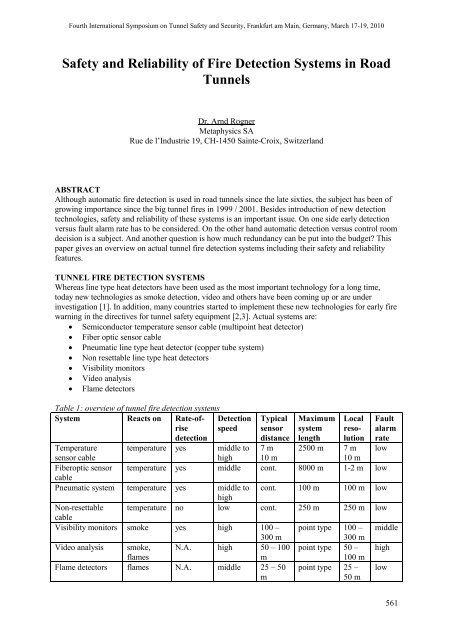
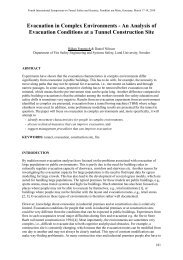

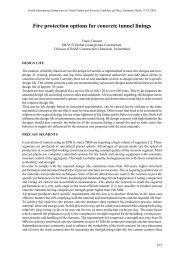
![30-37 TunnelsREV[1]rev.qxd - Industrial Fire Journal](https://img.yumpu.com/22237435/1/184x260/30-37-tunnelsrev1revqxd-industrial-fire-journal.jpg?quality=85)
